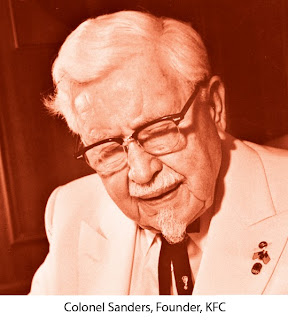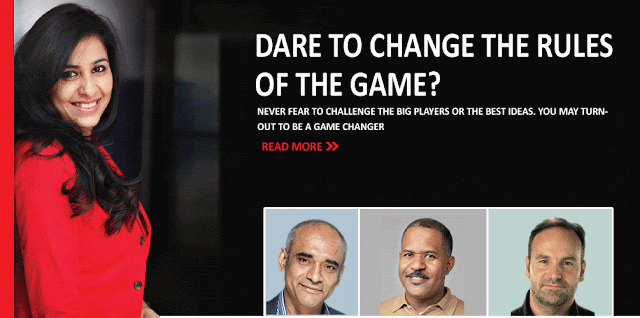Obama showed the world how you could market a President like a box of breakfast cereal. Kejriwal too meticulously planned out a marketing campaign and built a new brand that the consumers would love. His USP (unique selling proposition) was not unique as Obama had used the same sentiments but was unique for Indians. No politician had ever spoken like this to its voters as him. He had a message that people loved ‘Aap (you) against the corrupt biggies’. He inspired people to vote for change – just like Obama. He positioned himself as the ‘common man’ which appealed to the electorate and his logo (jhaadoo i.e. broom), his packaging (Gandhi cap), his slogans (power to the common man) all were totally in sync with the positioning and made him stand out distinctly from other brands (read: Congress and BJP).
Yes, it’s easy to say that he copied Obama, but the fact is not everyone can copy. You need to be really creative to copy and succeed. Mitt Romney too tried to copy every move of Obama but failed. He too used the Internet, he too used the slogans, but in spite of the US economy being in such a bad shape Romney could not swing the voters to his side. The fact is you may copy an idea but you cannot copy a vision. That is exactly what true innovators have. More than being plain creative they are visionary
Copycats are actually smart cats!
Agreed that creativity is not everybody’s cup of tea. Not everyone can really invent something extraordinary which can change the world, as it requires a different kind of intellect. However, there are some people who may not be creators but have the unique ability to spot a good creation, a good idea and use it to their advantage. When you think of the light bulb you think of Thomas Edison. However, the fact is he never invented the light bulb. It was Joseph Swan, a British inventor, who obtained the first patent for it. Edison was however the first to see the potential of the idea and worked hard to improve it and make it practical. The light bulbs of the past were very expensive and they did not last long, only 150 hours. Edison worked very hard to solve these problems. His bulb lasted for 1,200 hours and was cheaper. In fact, most of the inventions that Thomas Edison claimed were his like the movie camera, the telegraph machine etc were actually just ‘improvements’. Someone else invented them. He had the ability to spot an invention and quickly understand its marketing potential.
When you think of the concept of ‘touch screen’ you immediately think of the iPhone. Apple did not invent the touch screen. It had been there for donkey years. Steve Jobs just found a novel way of using the technology to his benefit. Invented in 1960s by E. A. Johnson, it was used by IBM when it released the first smartphone named Simon. Jobs saw the potential of this technology and rocked the world with his smartphone, which he called iPhone.
When you think of social networking you think of Facebook and Mark Zuckerberg. However, Zuckerberg stole the concept from the Winklevoss twins who came up with the idea of connecting all Harvard students online.
Be it Edison or Jobs or Zuckerberg all of them had one thing in common – they were smart enough to spot an invention, copy it and modify it to make it consumer friendly and profitable. You have to agree that Edison’s bulb was way better than Swan’s, it took a lot of hard work to convert the concept of connecting Harvard students online into a Facebook, and the iPhone was a landmark in the history of smartphones. You may call it stealing but as Picasso said, “Good artists copy, great artists steal”. In a 1996 documentary titled ‘Triumph of the Nerds” Jobs too quoted Picasso and said “We have been shameless about stealing great ideas” (No wonder the new iOS 7 has stolen ideas from various operating systems like Android, BlackBerry, WebOS, MeeGo etc).
So if you can spot a good idea go ahead and shamelessly steal it.!
It requires a lot of creativity to copy
It requires a lot of knowledge and intelligence to identify a good idea. You need to be really smart. You need to know what to copy and more importantly where and how to use it. Thomas Edison was one such person. He was a shrewd businessman and knew which idea was worth working on. As he very famously once quoted “Keep on the lookout for novel ideas that others have used successfully. Your idea has to be original only in its adaptation to the problem you’re working on”. Exactly similar to Steve Jobs who did not invent the first computer, or the first smartphone, or the first tablet. He just knew how to use these inventions and make them market friendly and also make him a lot of money. He could spot a good idea immediately and could quickly figure out how to use it innovatively. That is the quality, which is very rare. There are many people with many great ideas, but very few who have the capability to execute it perfectly.
A great idea without great execution is a dead idea
The hottest social networking site today is snapchat.com, which is based on a brilliant idea. It allows users to send photographs to each other but the photos disappear within a few seconds. Reggie Brown, a Stanford student, came up with the idea. He shared it with his friends Spiegel and Murphy, but the two friends ran away with the idea shutting out Brown from the company, and Brown too is fighting for compensation (like the twins of Facebook). The other two friends are arguing that besides the idea he did nothing much, they did all the hard work. Let’s see what happens to Brown, but the fact remains that an idea in itself is nothing.
It’s interesting to note that a lot of success stories are based on simple ideas. They could be ideas that maybe you had thought of too, but the person running happily to the bank is the one who had the conviction to go ahead and do it.
Many would have wished for a site where they could share photos with their friends, Flickr went ahead and created a site like that. Many like me must have wished for a phone with a USB drive so that a lot more could be done with it – and maybe somebody will go ahead and make one too.
An idea on its own is not such a great deal however brilliant it is. Behind each successful idea is a drive, a passion, and a crazy desire to succeed. If you have that you need not worry about people copying your ideas. People have and will always do so. You, your ideas, your brand, your business will always have to face competition.
What you need to always remember is that your one great idea will only take you a certain distance so the thing you need to focus is on the ability to come up constantly with new ideas, keep looking out for new trends and developments and keep thinking how to innovatively use them and passionately back those ideas with hard work and make them super successful. What you should not worry about is who is copying your idea, for you cannot stop that.
If you want to be successful, if you want to be different do not hesitate to be a creative copycat!

.jpg)


















